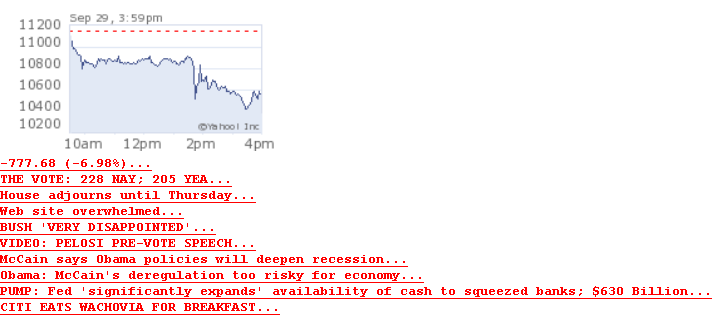Unless you’re a Wachovia shareholder, you had a happy Friday. Sellers didn’t stampede and buyers didn’t hide. (JPM shareholders even saw their holdings rise 10%.)
There are a few ways of reading this. One is that all is well, the storm has passed.
Another is that sellers, unable to contemplate the horror of no Congressional approval of the $700 billion bailout package clung, simply shut their eyes and hoped for the best. With eyes squeezed shut, shareholders ignored the Chinese banker’s embargo on trading with Western banks, the new high in initial unemployment claims, the frozen money markets.
I’m think it wasn’t good will the kept sent the market sideways Friday, but paralysis. The gravity of our situation is hard to comprehend, much less stratetize for. What do you sell? Where do you move your money? The average American, even the average American fund manager, doesn’t have goggles big enough to imagine what a post-credit world might look like.
It’s interesting to know that even as Wall Street traded sideways, Treasury officials were secretly warning Congress of a 3000 point Dow meltdown.
One Republican said that the message from government officials is that “the economy is dropping into the john.” He added: “We could see falls of 3,000 or 4,000 points on the Dow [the New York market that currently trades at around 11,000]. That could happen in just a couple of days. What’s being put around behind the scenes is that we’re looking at 1930s stuff. We’re looking at catastrophe, huge, amazing catastrophe. Everybody is extraordinarily scared. It’s going to be really, really nasty.”
Back to Wachovia. Citigroup, Wells Fargo and Spain’s Banco Santander have apparently been approached by Wachovia management after its shared traded as low as $8, down from $14, on huge volume Friday. But, as one article (can’t find it now) noted today, potential buyers are incentivized to let Wachovia wash out, like WaMu, and then, like JPM, buy the quality assets post failure. After years of chasing assets higher, buyers are learning that, once again, cash is king and time is always on the buyer’s side.

